A personal cinema? A wearable iPad? A doorway to immersive futures? This is Apple's wildest and strangest device
It's easy to lose track of where I am when I'm wearing the Vision Pro. And it's thrilling.
I'm on a FaceTime call with a colleague in San Francisco. I see her in 3D in front of my face, part of a sweeping landscape of apps and images laid out in front of me -- like an iPad exploded into space. After our call, I hang up and, with the headset still on, turn a dial to draw back the virtual landscape, revealing the reality outside the Vision Pro: CNET's video team all around me to capture the experience. Worlds within worlds within worlds.
I've dreamed of the future in VR and AR headsets for years: Oculus, Magic Leap, HoloLens and countless others. But living in the Vision Pro for the past week has been one of the most complex experiences of all. It's one of the hardest products I've ever had to evaluate. Parts of it are stunning. Others don't feel entirely finished. It's unbelievably expensive ($3,499 and up, and only in the US for now), but also full of futuristic parts at every turn. Did I mention my eyes animate on the outside of the headset's glass for everyone to see, like half-submerged, half-virtual parts of myself?

You can see my unreal real eyes. This is just one of the shocking things about Vision Pro.
Apple's big bet on the immersive future is also a big step into a new phase of devices that intertwine with the software we already use on our phones, tablets and computers. The Vision Pro runs on a new operating system, VisionOS, but it's still essentially an iOS computer inside a mixed reality VR headset, with the benefits and design challenges of each but elevated with a whole bunch of new features and ideas.
The headset is the best wearable display I've ever put on. But at its price, and with so few VisionOS apps at launch, the Vision Pro isn't a device I'd recommend to any of my friends or family. If you're in the immersive industry and can afford one, then that's another story. But for anyone else, I'd recommend you get a free demo at an Apple Store, marvel at its features and wait and see. That said, I can't stop thinking about it. Also, I wrote most of this review in it. I'm still inside.

The Meta Quest 3 (left) next to the Apple Vision Pro. Similar size, but very different functions.
What it does that's different than the Quest and everything else
There is a class of VR headsets capable of mixed reality that passes video which is captured with cameras on the outside to displays on the inside. Meta's Quest Pro and Quest 3 have mixed-reality functions, and so do the HTC Vive XR Elite and Varjo's high-end PC VR headsets. Apple's Vision Pro is the most advanced blend of mixed reality in a standalone device that I've ever experienced.
The Vision Pro is studded with cameras and sensors: Multiple cameras on the outside, a lidar sensor and TrueDepth camera (which the iPhone uses for front-facing cameras and Face ID scans), infrared sensors and more cameras underneath, and extra eye-tracking cameras and sensors on the inside. There are no controllers; every interaction is done with your eyes and hands, or via speaking to Siri using the built-in microphones. Hand and eye tracking even works in the dark -- light is needed for room tracking, but not for hand tracking. Lying in bed one night, I watched movies on my bedroom ceiling.
Check Out Apple's Vision Pro Headset and Everything in the Box
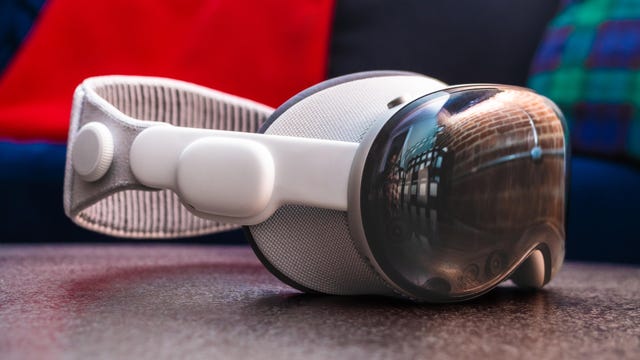
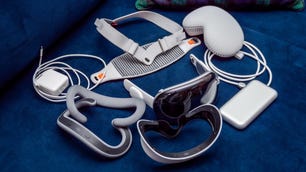
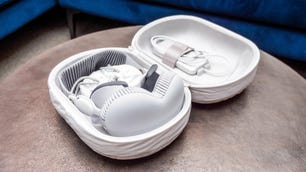
Although the Vision Pro has its own apps, it runs many iOS apps, too. It's hooked into iCloud as well as Apple services like iTunes, Apple TV Plus and Arcade. There's an M2 chip inside, which equates to roughly the same processor in the 13-inch MacBook Air, or the last iPad Pro models.
The display quality and the finessed interface make the Vision Pro feel like it's in a whole other class, though. The dual 4K micro-OLED displays, a technology that will make its way to other headsets in the future, are rich, vibrant and way above what competing devices offer. Apple's hand and eye tracking is always on, and often fantastic (but not always). Also, the Vision Pro requires no room setup at all. The depth mapping and spatial awareness happen invisibly, something I haven't seen before either.

The Vision Pro's look feels iconic, but that battery and cord is something to consider.
iPhone meets Ready Player One
As my colleague Bridget Carey said, the Vision Pro looks like an iPhone merged with a Meta Quest. The outer part of the Vision Pro, all the processing and outer displays, has the aluminum and glass contours of an iPhone, but the top buttons -- including a large rotating digital crown and a flat clickable button for Apple Pay and camera capture -- are like an Apple Watch. It feels dense and I want to protect it from damage.
The headset's required "light shield" and cushions resemble the spacers on VR headsets like the Quest, but they attach far more easily, magnetically snapping on and off. The side arms of the Vision Pro are where the speakers live, in bubblelike buds that project down to a wearer's ears like the Quest. The head straps snap on easily and are removed via a little tug on orange fabric pull tabs. It's a sleek design that has surprisingly comfy materials.

No shortage of accessories that come in the box.
What's in the box?
The Vision Pro's box is big, but the Vision Pro itself is pretty small, about the same size as a Meta Quest 3. It's heavy, though (approximately 1.3 pounds, and that's not including the battery pack, compared to the roughly 1.1-pound Quest 3). The box is filled with accessories:
- Two head straps for different fits.
- An extra face cushion (one's a bit thicker than the other, for those wearing prescription lenses).
- A proprietary battery with a cable.
- A cushioned front-cover cozy for the headset's glass front.
- A USB-C 30-watt charging adapter.
- A USB-C cable.
- An Apple polishing cloth (which Apple says should be the only cloth you use to polish the Vision Pro, but microfiber cloths should be fine).
- And… an instruction manual.
Apple doesn't usually do instruction manuals, but the booklet is a guide to attaching the battery, adjusting the fit and operating the headset. It's a sign that setting up and navigating this spatial computer is a whole new universe, and not always intuitive.

I need Zeiss inserts.
My eyes and Vision Pro
Unlike many VR headsets, Apple's Vision Pro doesn't work with glasses at all. That's a trend I've seen coming for years, and it's upsetting. Instead, Apple requires prescription lens inserts, made by Zeiss, that cost anywhere from $99 to $149. I got outfitted for a pair that corrected even my severe nearsightedness (-8.50 in one eye), although I've heard of some people who don't meet the prescription cutoffs.
Meta and other headset manufacturers also have prescription insert options -- I've been using a pair of lenses with the Quest 3, made by Zenni -- but most other VR headsets also have spacers that allow the wearer to wear glasses, too. The Meta Quest Pro, for instance, allows glasses.
The Zeiss lenses come in a cardboard sleeve, along with a QR code card for setup. Scan the code with the headset's cameras and the device optimizes the displays for the lenses. The lenses snap in magnetically, and they're easy to pop on and off.
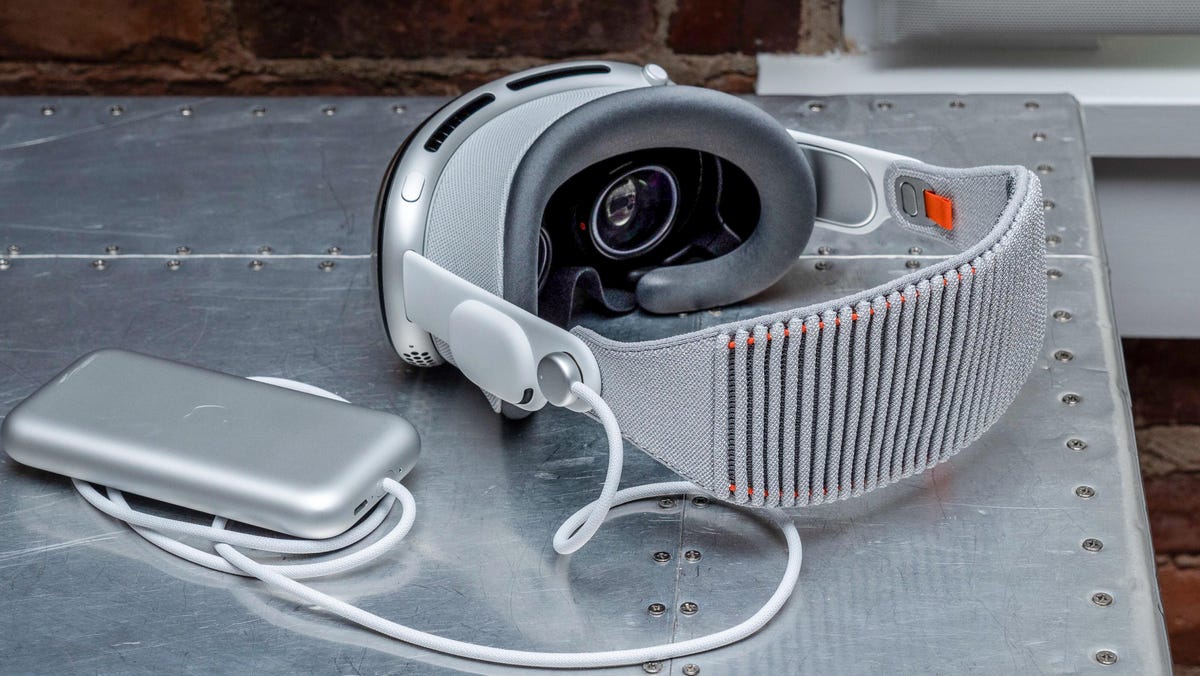
The battery pack is a weird part, necessary and hard to store.
My first dive: Spatial computer = facial computer
There are parts of the Vision Pro that feel like any other Apple device, and parts that decidedly do not. First I needed to adjust my head straps. The preattached Solo Knit headband feels like a padded ski goggle head strap, stretching around the back of my head and tightening with a knob on the side. It's comfy at first, but after half an hour the headset feels top-heavy and pushes in on my cheeks a bit. It's fine for short sessions, though. The other head strap is a Dual Loop band that looks like the headband on my CPAP machine and tightens on the back and over the top of my head with Velcro. The weight balance is better; this is a better fit for long work sessions.
The battery cable to the Vision Pro is odd -- it's a locking, unique circular attachment that needs to be slotted in at an angle and then turned to lock in place. It's to prevent losing power when using Vision Pro, but it also means you can't use a regular USB-C cable to power up or charge the headset unless you route it through the Vision Pro's large, heavy battery, which weighs about 0.75 pounds. I just put the battery beside me, and sometimes tuck it in my pocket. The fabric-covered cord to the battery, which isn't removable, is long enough to tuck nearby but not long enough to snake across a room.
Like an iPad or Mac, you can bring your iPhone near to the Vision Pro to start setting it up, and it copies your account over easily. Familiar opt-ins are offered: Apple Pay, location services and sharing data with Apple. Others are less familiar: An eye-tracking setup, like a video game, has you stare at a ring of colored dots and tap your fingers to click on each one. The headset has me stretch my hands out to scan them. Then there's Persona setup, which scans your face into an uncanny avatar for FaceTime, and also puts your eyes on the front of the headset. Welcome to the weirdness (you can skip Persona setup till later, though).
But once that's done, a recognizable grid of apps appears. A lot of VisionOS feels familiar, by design.
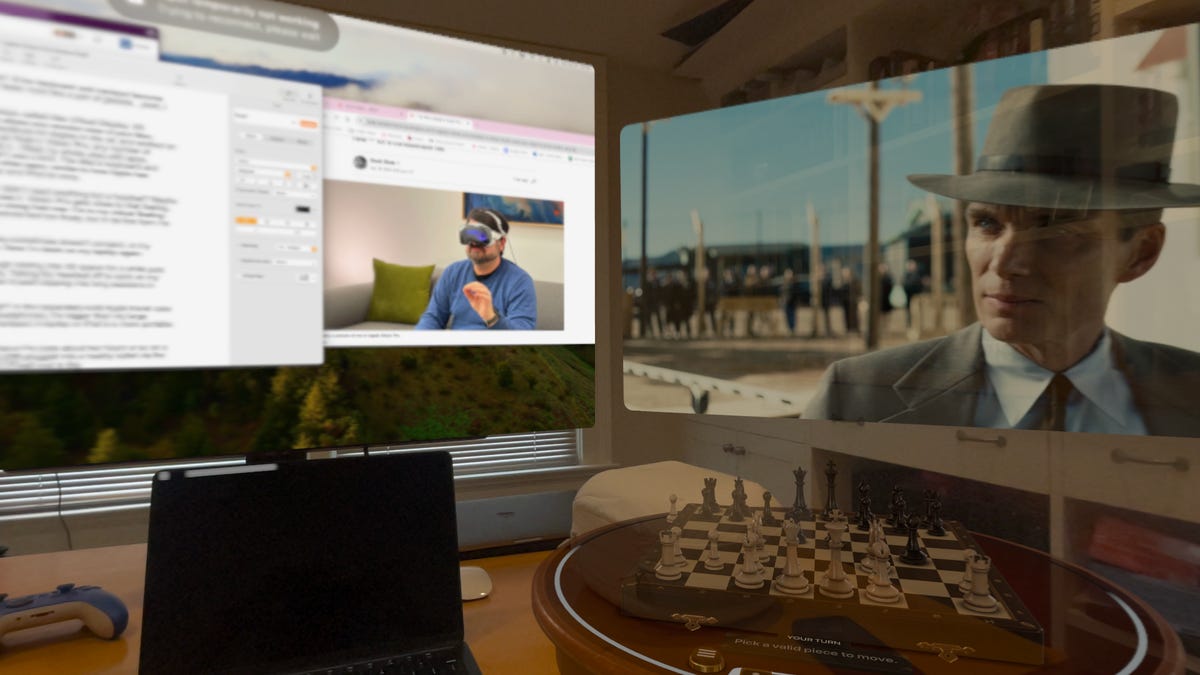
A screenshot of me living in a screen-studded world at home on Vision Pro. Note the virtual chess board.
VisionOS: Where it is and isn't iOS
Apple's iOS-based mixed reality OS is its unique software advantage versus any other VR/AR headset out there, and it immediately shows. Once my iCloud account is added, all my hundreds of thousands of emails are there. There are my photos, my notes, my documents, my Safari bookmarks.
An app grid pops up when you press the digital crown, similar to an Apple Watch, but opening apps brings up resizable windows like an iPad in multiwindowed Stage Manager mode. Apps can be placed anywhere, resized and dragged forward or back in space.
That's also true for 3D apps, for the most part: I could wildly layer 3D games What The Golf, Cut the Rope 3 and Puzzling Places side by side, while also watching sports. The apps overlap and ghost over each other, but each one only activates when you look at it and tap your fingers. It can get confusing, but the possibilities of simultaneous work are fascinating.
Controls take getting used to. Any icon or button I look at is highlighted, grows in size or glows, and tapping my fingers selects it. It's jarring at first, but intuitive.

Controls in Vision Pro, like moving a chess piece, include hand gestures.
Control Center, a pull-down menu on iPhones, is a hovering dot that floats above my field of view. It becomes an arrow when I stare at it, then expands into familiar controls for Wi-Fi, Bluetooth and screen recording, which has been super helpful for this review. That Control Center dot can be shifted higher up in settings but sometimes gets in the way when watching movies or playing immersive games.
There are some missing settings I'm used to in iOS that aren't in VisionOS (no Screen Time settings, for instance), and there's no FaceTime app. Instead, in the main app grid, there's a toggle for People where contacts can be pulled up and FaceTime calls started. The Messages app lets me respond to people, including green bubbles.
AirDrop is here, and it works as easily as on iOS. So is the Files app, so I can upload things through a phone or iPad or Mac and pull them up here, or vice versa. It's really easy to hop back and forth between devices -- or a lot easier than on something like a Meta Quest.
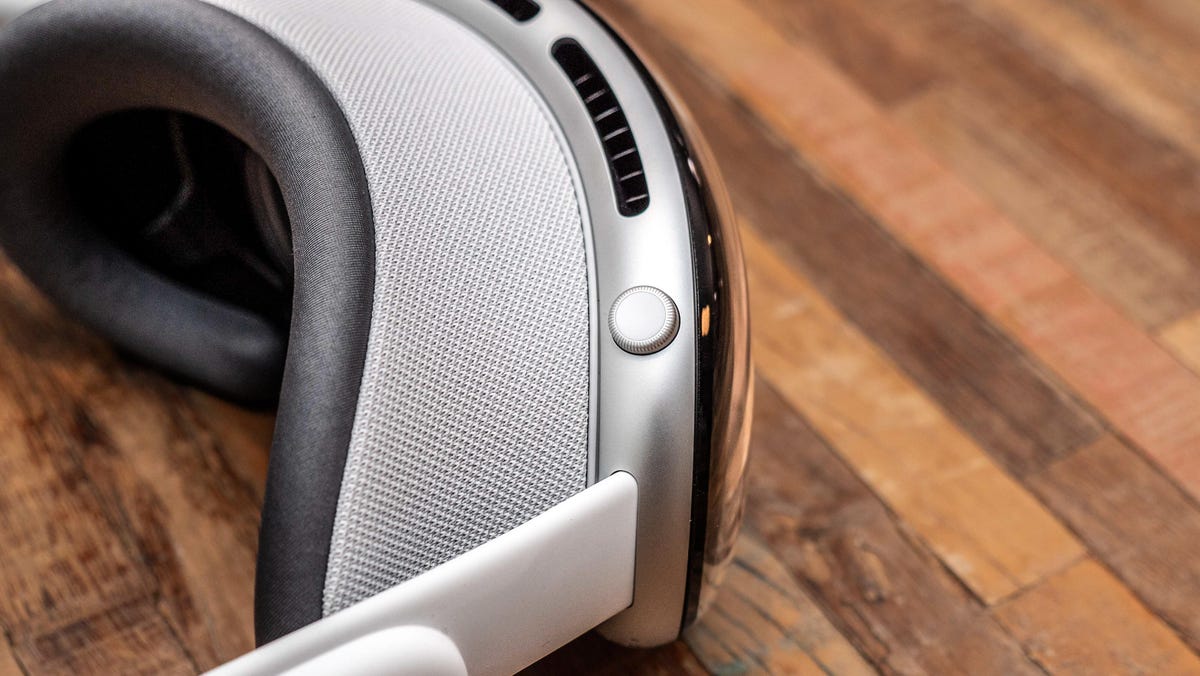
The digital crown on the Vision Pro dials reality in or out, with levels in-between.
Blending reality -- or shutting it out completely
Apple's mixed reality tricks on Vision Pro are ever-present, and a huge part of how the headset works. Much like the Quest 3, the headset uses its passthrough cameras to see the real world in 3D while layering virtual displays and apps on top. Apple does it by default, though, from the very first launch screen with an app grid hovering in your room. Apple's passthrough cameras are the best I've seen, with almost no distortion. There's a bit of blur and lag when I turn quickly from side to side, and the quality dips in low light, but it's good enough to see details in my room through. I can read my laptop screen, use my phone, check my Apple Watch or even look at something on TV.
Displays and apps float in space with subtle virtual shadowing appearing on my real floor. But virtual screens don't recognize real objects or people. They'll just overlap. Virtual displays will block out real things, but Apple has included a clever trick for person recognition that makes anyone in eye view start to ghost through your virtual environment or even apps if you want. It's designed to help with presence and feels like a visual version of Apple's adaptive audio on AirPods that lets conversation in.
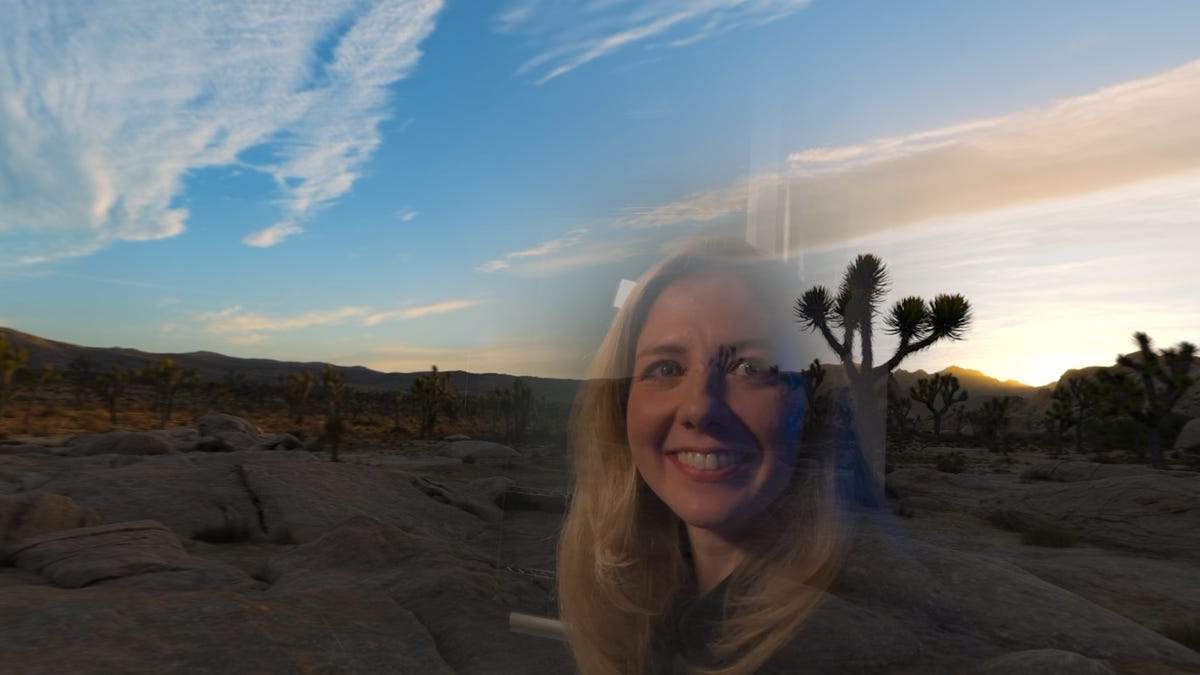
Bridget Carey, ghosting through my virtual Vision Pro world from the real world as she sits next to me.
Turning the large digital crown on top of the headset brings a virtual environment in, like a curtain. It can be partial or full. When fully surrounded, you're basically in VR. The crown controls volume, too, when you gaze at the volume icon, switching functions from whatever you were previously controlling like it's powered by mind control.
There are several immersive environments you can work in, although I expected more. There's the moon (a lunar surface), the edge of a volcano in Haleakala, a snowy forest in Yosemite, a lakeside at Mount Hood, a white-sand desert or several filters that tint the passthrough environment. Some apps also have their own sub-environments, such as Apple TV, which offers a curtained black box movie theater mode, and Disney Plus, which has some themed Star Wars and Avengers environments.
Even though Vision Pro doesn't do any room setup to map your room, as basically any other headset I've ever used has done, it still has room awareness. This shocks me. It's scanning and using depth mapping invisibly. When I get too close to an object, the virtual things in front of me go transparent and the headset warns me to move back. It's a real-time warning system.
And yet, there doesn't seem to be a lot of blending of virtual and reality in apps or environments. I haven't seen virtual things hop on my sofa, or run behind furniture. I haven't placed apps on walls or turned windows into aquariums. Apple's ARKit on iOS already can do this, but so far Vision Pro isn't emphasizing these tricks. I'm curious why not.
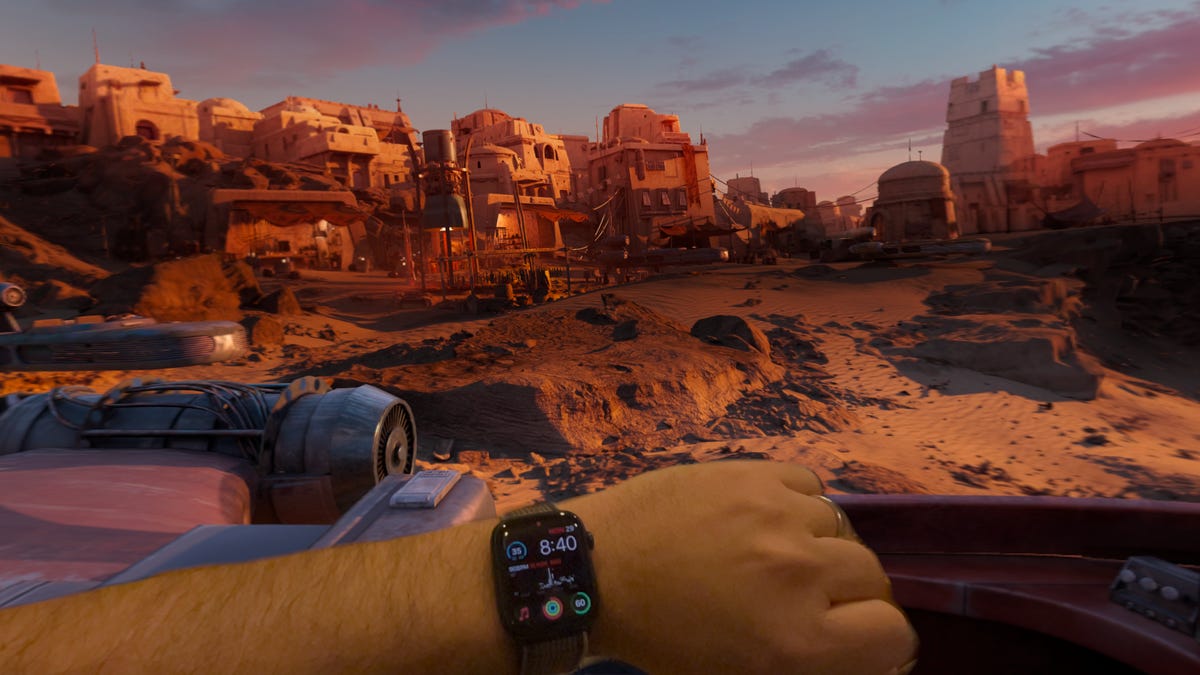
Me checking my watch on Tatooine, in Disney Plus' Star Wars environment.
Vision Pro does love showing my hands, though. Real hands show up over virtual displays, in VR-like games and apps, and can always be seen. They're outlined in a fuzzy border like they're green-screened, but the effect is impressive. It also means I can always check my watch and read messages. Apple is clearly thinking of Apple Watch wearers here.
One thing that happens subtly and impressively is spatial audio. I watched the AFC Championship Game on Paramount Plus on a window in Vision Pro as I typed this, and the sound is coming from the TV area like it's hanging there. Apple says audio is realistically echoed around a room based on the sensed dimensions (audio ray tracing, Apple calls it). All I know is it sounds natural and helps create the illusion I'm looking through glasses at things in the real world.
Is the isolation too perfect sometimes, though? I watch movies with AirPods Pro buds in, turning my living room into a movie theater. After a while my son taps me on the shoulder and asks if I'm asleep. I say of course not. But my wife says she doesn't like this, that I'm so removed from everything. My son calls it a phone for my face. They have a point. My wife also says she's concerned about me getting lost in digital memories. Part of me thinks this is very real, and another part of me thinks this is an extension of what's already happened on our phones. While the Vision Pro creates presence by showing the real world through its passthrough cameras, or even replicas of my eyes, it also allows me to close these off, even sealing my audio world completely with AirPods. I can be in my own world, inches from my own family.
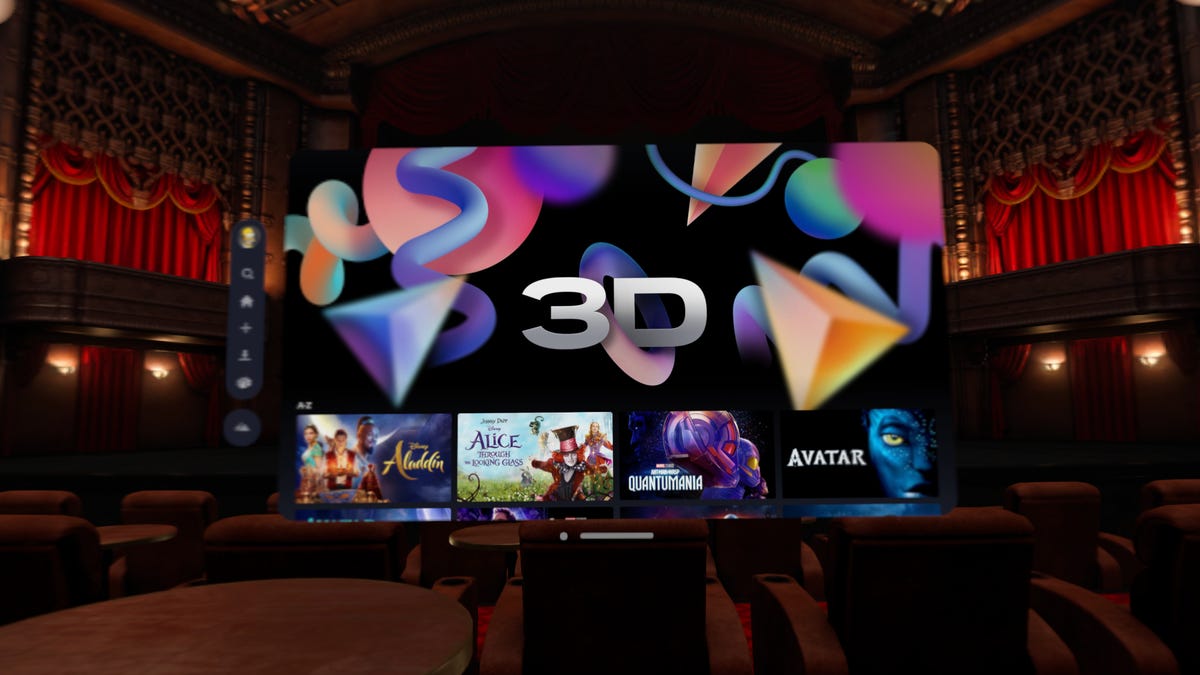
Disney Plus on Apple Vision Pro has a bunch of 3D movies, and this cool Disney Theater environment to watch them in.
My personal cinema
The very first thing I noticed about the Vision Pro in my first demo was how good the displays were. The 4K-resolution-per-eye, micro-OLED display tech Apple uses is basically the "retina" moment for VR and AR. It's vivid, richly colored, HDR and just stunning. Not only is it good enough for movies -- something Apple is touting constantly -- but it's better than any TV in my house.
There are limits, though. Apple isn't specifically confirming the field of view, but it feels a bit smaller than the Meta Quest 3, like seeing an amazing monitor through a scuba mask. The headset's refresh rate is generally around 90Hz but can go up to 100Hz. Some VR headsets can do 120Hz, but the Vision Pro looks great for film and video, and seems fine for games so far, too.
This type of super-high-res display works through some cognitive magic. Apple uses foveating rendering, which uses eye tracking to improve detail where you're looking while decreasing resolution in your periphery. It's not noticeable during use, but in screen captures recorded in Vision Pro's iOS-like screen recording mode, which you can see in our CNET video, you can see areas that are less detailed in the areas I'm not looking at. Also note that the screen captures in this review have clearer and less-clear areas, too. That doesn't show up at all in-headset, where the experience looks incredibly vivid and crystal clear.
Right now, the closest thing to a killer app the Vision Pro has is its cinema-level video playback. That's a hard sell for a $3,499 headset, but if you go for a demo and see it, you'll probably be just as stunned as I've been. Movies can float in your room like hovering TVs, or be placed in a virtual cinema mode.
Apple supports 3D films, and a number of Apple TV purchases in my library have been upconverted for free: Dune, Ready Player One, Mad Max Fury Road and the recent Star Wars films. Disney Plus has a bunch of 3D films, too. Avatar: The Way of Water -- a movie I wondered about seeing in a high-end 3D headset since I saw it in Imax in 2022 -- looks lovely. It sometimes gives me chills.

Watching a trailer for The Boy and The Heron in Apple Vision Pro's Cinema environment. I want to be here all day.
Apple's also working its own 180-degree immersive video format into Apple TV Plus, with a series of shows and programming coming. A few episodes are already available: a 13-minute documentary series called Apple Immersive Adventure, with the first episode about Faith Dickey, a highliner crossing fjords in Norway over a tightrope. There's also a three-minute immersive episode of Prehistoric Planet, full of beautiful CG dinos. Alicia Keys: Rehearsal Room is a video showing her during a recording session, and there's also an immersive nature film of rhinos. Apple's Immersive Video format feels like 3D Imax, room-filling and detailed. It's like an enhanced version of YouTube's 180-degree VR video format I tried years ago. Apple is promising sports and more in this format. It's exciting to imagine, but unclear what the rollout for future content is.
The built-in speakers on the Vision Pro also sound great, good enough to appreciate a film. The speaker buds are open, angling down to aim at your ears similar to Meta's Quest headsets, and can be heard by others in the room. A more enclosed feel comes if you slip in AirPods, which autoconnect seamlessly. Apple recommends the USB-C AirPods Pro model for lossless audio and less lag, but technically any pair will work.
There are plenty of video providers that are already on Vision Pro, including Peacock, Disney Plus, Paramount Plus, Mubi and the NBA. Netflix and YouTube are noted no-shows, but it's easy enough to play them in the Safari browser, similar to using a laptop. Only one video window plays at a time right now; if I have an NBA game on and then open Peacock to watch Mrs. Davis, the game pauses. It would be nice to keep multiple streams open to scan something with the audio off.

Hi Mom, you're in my Vision Pro.
My memory machine
Apple is also expecting the Vision Pro to be a place to see all your own life moments, reliving them like a scene out of Minority Report. I tried watching recorded "spatial videos," which are 3D videos that I previously shot on an iPhone 15 Pro. I also played back 3D videos and photos recorded directly with Vision Pro, which has its own cameras.
The Vision Pro needs relatively well-lit rooms to record video, unlike the iPhone, but can shoot photos anytime. The photo and video quality in 3D isn't as good as Apple's stunning 180-degree Immersive Video format, not even close. But when expanded to a fuzzy-bordered viewing mode, it starts to feel like a replayed memory. I went back to the holidays, to the Museum of Natural History, to a hot pot dinner with a friend in San Francisco, to a snowball fight with my kid. I started to forget where I was and imagined I could just walk into the moment.
I'd never wear the Vision Pro to take photos and videos of my family, not unless I was already in-headset and just wanted to capture a moment quickly that I saw. My kids find the idea as invasive as me shooting photos and videos on Meta's Ray-Ban glasses. But I definitely shoot on the iPhone, and it's great that the videos and photos are 2D-viewable even if you don't have a Vision Pro. It's possible that they may be VR-viewable on headsets like Quest more easily over time too (I hope).
Again, panoramic photos wrap around and look like a window into another world. I've already discovered a ton of old panoramas I forgot about, and am marveling at them. A trip to see the New York Jets play in Green Bay surrounds me like a scene from VR.
Apple's immersive videos aren't volumetric, meaning you can't walk around them, or "lean" into them. They're just 3D, like any 3D film you've ever seen before. But it's a foot in the door. The frame rate and resolution don't feel good enough to be ultra-real yet, but Apple has evolved its cameras at a pretty impressive clip over the past 10 years.
While this isn't the No. 1 reason I'd use a Vision Pro, it's compelling. Having all my photos and videos on tap on a big screen is fun and it's a lot better than viewing on my phone or laptop, or even my TV.

Hello, there.
My face, made virtual
Now let's get to the weirdest part of Vision Pro: how it virtualizes my face. I blink my virtual eyes at my wife as I sit in the living room, and she doesn't know what to make of it. Neither does my colleague Bridget Carey. It looks like, on the outside of the Vision Pro, that my eyes are there, peering through muddy glass, underneath. They're not my eyes. They're a 3D scan animated on a lenticular display under the glass.
Apple's decision to add a display, called EyeSight, that shows your eyes despite being goggled in what's basically a VR headset is one of the boldest design moves this device has, and it's a mixed bag. The fascinating display is tech I haven't really seen before. It looks 3D, sort of. It seems to float deeper than it is. And it's dimmer and lower-res than I expected. It's surprisingly hard to photograph or film.
These eyes only appear when someone is nearby to look at me, I think. When I'm in an app, the display becomes a shimmering iridescent thing, indicating I'm in an app. Sometimes my eyes seem to half-appear. And they blink. They seem to frown, or dart around, or go wide or squint. They animate as my face emotes. It's uncanny.
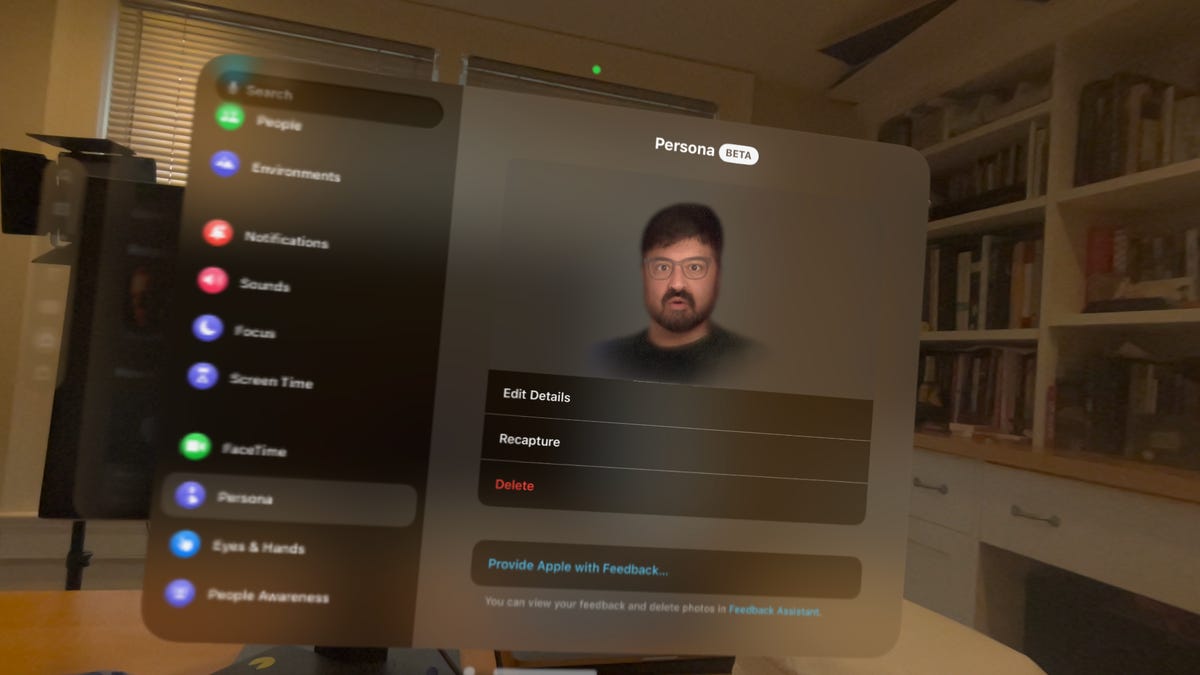
My Persona is a scan of my own face, animated to match my facial expressions. You can only save one at a time for yourself.
These eyes appear thanks to Persona, a face-scanned personal avatar Apple is launching in beta. Unlike the Meta Quest, which constructs a cartoon avatar for your virtual personification, Apple scans a unique, almost photo-real version of yourself that's locked to your own account and stored locally on the headset. Per Apple, it's secure and you'd need to use your own iris-scanned Optic ID to access it.
The Vision Pro has a Guest Mode which can demo apps to anyone else who wants to check them out, but that person won't be able to use your Persona.
This Persona is used for FaceTime calls, Zooms or anytime you'd connect with anyone with camera-based chat. It's a necessary concept since, when you're wearing a VR headset, you can't show your face in video. My Persona facially animates: I can stick out my tongue, move my lips, frown and smile. It's like a hyper-real Animoji.
Meta has a similar type of tech in the works called Codec Avatars, which I saw at Meta's Reality Labs back in 2022. Apple is debuting its version first, but it's a work in progress. I tried it in some test FaceTimes, and it's weird. My family thought it looked like an airbrushed almost-version of me. Another colleague, Lexy Savvides, was weirded out.
And I can't wear my real glasses with my Persona. The scan is made by me holding the Vision Pro out in front of me, turning my head around, making a few smiles and closing my eyes, but all without glasses on. Apple adds virtual glasses afterward, offering about 20 virtual pairs, but they're all smoked-glass colored, and none perfectly match mine. It adds to the weirdness.
Apple admits it's still exploring how to capture diverse faces well, and there may be changes to Persona -- hence the "beta."

Opening a few 3D games in Vision Pro while also watching some of a playoff game. Apps become semi-transparent when they overlap.
Apps: Not a lot, but plenty of iOS ones
The biggest unanswered question about Vision Pro is how many unique apps will emerge for it. At the time of this review, prelaunch, the App Store shows Vision Pro-optimized apps, but pickings are slim. Apple has a few Vision Pro games in the subscription-based Apple Arcade, including a full-motion game called Synth Riders (a popular VR game that uses my hands to control balls that hit rhythm targets to a soundtrack, almost like Meta's Beat Saber). Game Room, by VR developer Resolution Games, floats 3D chess tables and card games into my room, where I can control pieces by tapping my fingers and dragging.
Mobile games like Cut the Rope 3 and Bloons TD 6 are here, too, with mildly immersive framing devices, but feel like floating phone games. Puzzling Places, a VR game with 3D puzzle pieces you put together (one of my favorite Quest games), is also available.
You could play lots of other games on Vision Pro via iOS compatibility if they show up in the App Store. I saw plenty. You could pair a game controller and play on a virtual big screen. That's a fun idea, maybe.
But will many immersive mixed reality or VR games really make the move to Vision Pro, considering its lack of VR game controllers and the limited early-adopter nature of the hardware? Easy answer for now: If you want immersive gaming, just get a Quest 3.
It's all the rest of the iOS apps on tap that make Vision Pro interesting. I've already loaded Slack, X, Microsoft's apps, Paramount Plus, Luma Fusion and Darkroom. Using them in a VR headset is unique, and makes me feel like I'm extending my workspace all around me.
The other apps, the more immersive ones, feel few and far between. But they show some hints of promise.

Reaching out to dinosaurs in my office. Regular work day.
A Lowe's Design app, for example, just walks through a simple VR-like demo of picking out customized kitchen designs. Encounter Dinosaurs, a preloaded experience that's like an immersive promo for Apple's Prehistoric Planet series is a short several-minute dive that opens a wall of my room and shows realistic dinosaurs emerging from it. DJay opens up virtual 3D turntables in my room that I can spin records or lift the turntable arms on; it feels fun, but my hand interactions feel limited.
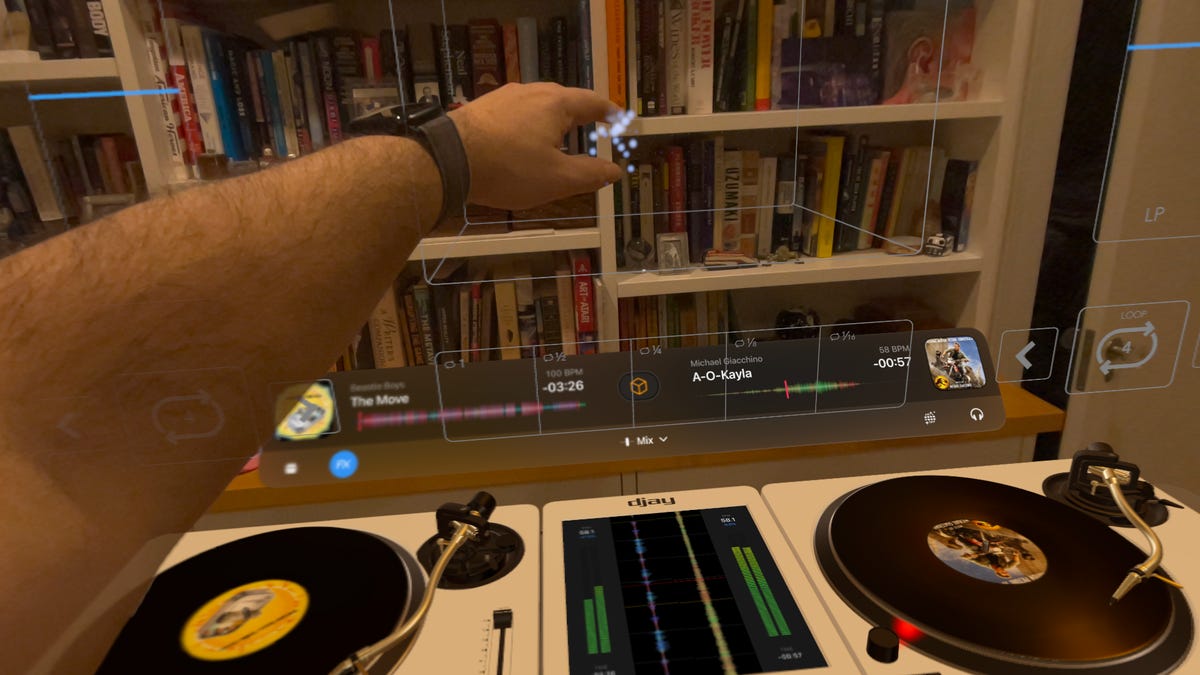
Mixing up turntables and adding effects with the AR app DJay, in my home office.
Jigspace, a longtime AR-enabled iOS app, is on Vision Pro with a handful of available objects and sample instructions to demo (like a jet engine and an F1 race car). Grabbing items gets a little awkward, though. Again, I have to look and pinch and drag 3D things. I wanted Apple to have a more advanced interaction model for 3D objects and environments, but it's still mostly pinch-and-drag, just like everywhere else in the OS.
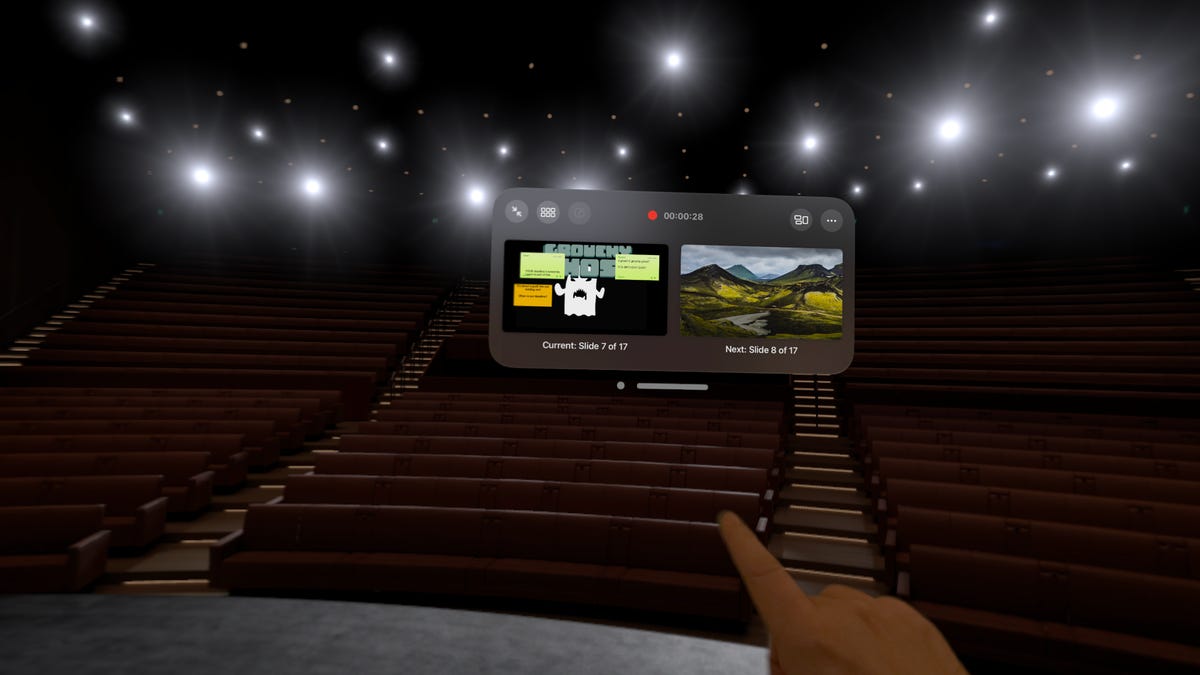
Apple's Keynote app drops you into the Steve Jobs Theater. Recognize the pitch deck?
Some of Apple's own apps are Vision optimized, others aren't. Freeform, a collaborative whiteboard-like app, which I expected would be a Vision Pro mainstay when it was first released, is front and center. Keynote has a rehearsal mode where I can test a presentation in a virtual version of Steve Jobs Theater. Mindfulness presents some short meditations with a beautiful spray of glowing translucent rainbow flower petals and an audio guide, showing potential for more mindfulness apps to come (it was nice to try in bed one night before I went to sleep).
But there are plenty of missed opportunities. Maps, Apple's app which already has rich 3D detail, isn't VisionOS optimized. Pages still has the same interface as the iPad version. GarageBand (which could have had virtual instruments) isn't optimized, and neither is iMovie. Apple will certainly adapt these, over time, but not yet.

Vision Pro as my computer: a whole bunch of complex thoughts here.
My everywhere computer
I've been trying the Vision Pro as my own computer and it feels like monitors all around me. Over to my left is a 3D golf game. To my right is a floating set of photos. I've paired a Magic Keyboard and Magic Trackpad. I can float a TV. I can ask Siri to start playing some music.
I can see my keyboard keys and the trackpad. It's weird that I can also see a smart type toolbar that appears virtually, staying right above wherever my physical keyboard is, moving when I move it like a virtual halo. Occasionally I glance at it and trigger dictation, which I don't want. Sometimes my eyes accidentally trigger an action. Also, some of the iPad-like Pages options are hard to select, and feel less intuitive for a big screen. There's an odd struggle, still, between virtual and real.
But it's crazy how much does work. I'm writing this on a new product that hasn't even launched yet, and it already feels pretty powerful.
I can also connect Vision Pro with a Mac, using a feature called Mac Virtual Display. VR headsets like the Quest can do this too. Apple only allows one monitor view of your Mac, although it's a nice big 4K version, and any number of Vision/iOS apps can also float simultaneously around it. I filled my whole area with apps, overlapping them in semitransparent layers. The Mac's keyboard and trackpad cursor move across the Mac view and into other apps, similar to how Apple has allowed Mac and iPad keyboards to control a nearby Mac and iPad at once.
What if my desk was just floating monitors? What if I didn't need anything but a headset? Vision Pro gets close to that feeling when all the apps are open and the flow is going. I'm doing that now. I'm in my virtual floating computer as I write this. There are glitches, and sometimes the controls feel too floaty, but in its first form, I'm shocked at how good it already is.

Typing on a Magic Keyboard floats a virtual toolbar above it. It follows the keyboard around.
It's great, except for when I find that the virtual display sometimes doesn't connect, or my display shows a connection problem and freezes up. (Apple says this is a preproduction issue that will be addressed by launch.)
And while the Vision Pro's display is great as a monitor, staring into 3D space for a while puts my eyes into a different focus zone than actual reality. Taking the headset off to work on my laptop, my eyes need time to settle and refocus. I feel myself slipping into long sessions in Vision Pro, but my eyes want me to take breaks.
Will I carry Vision Pro around like a computer? In the Apple travel case (sold separately for $199), the Vision Pro is like a very bulbous set of headphones. It's bigger than my large backpack can hold. Also, I'd need a keyboard and trackpad. A laptop or iPad is a more portable option, and less in need of special packing care.
And there's the limited battery life. The Vision Pro lasts about two hours or so on a charge despite its big battery. You could keep it USB-plugged into a nearby outlet via the battery, but that's a lot of cabling. By comparison, my MacBook Air lasts well over a day.

Apple's travel case for Vision Pro costs $199, and I can't imagine buying a Vision Pro without it.
How much will this really cost you?
The Vision Pro starts at $3,499, but that's with 256GB of storage. Apple also sells storage tiers in 512GB ($3,699) and 1TB ($3,899). (Prices and release dates for countries beyond the US are still yet to be announced.) I tested a 1TB Vision Pro and have already filled about 130GB easily. I'd be concerned about filling the 256GB version fast, considering apps are around a few gigabytes apiece so far, syncing my Photo library took up 13GB alone, and downloading a 3D version of Avatar: The Way of Water on Disney Plus occupied about 24GB.
Then there are the extras. I need prescription lenses, which cost $149. A carrying case seems like a must for such a potentially delicate product with a curved glass front, but Apple's nice padded case costs $199. AppleCare Plus also seems like a better idea here than with any other Apple product considering we don't know yet how durable Vision Pro even is, and that's another $499. It's a lot. Like, a lot a lot.
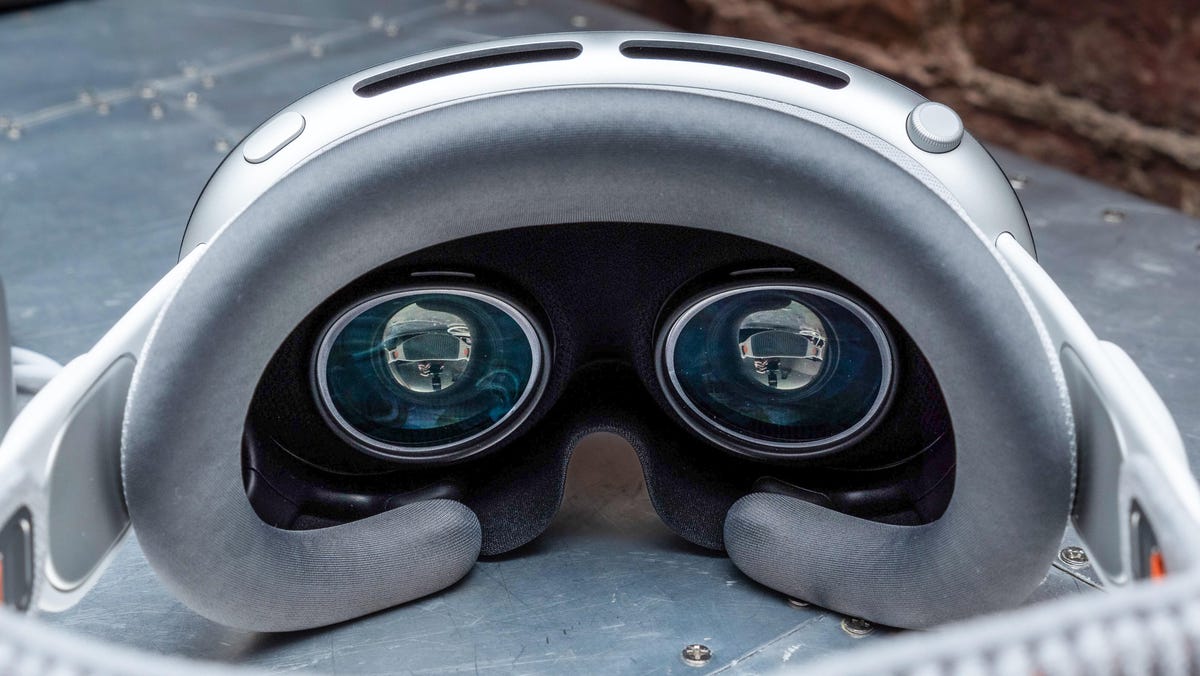
What comes next for the Vision Pro? It feels like an open door.
The dream vs. the reality
I had this weird moment, watching Ready Player One in 3D in the Vision Pro. I got a little teary. I thought about dreams versus reality. It was a theme I visited when former CNET editor Sean Hollister and I reviewed the Oculus Rift back in 2016. Now I'm thinking of it again, in a whole new way. The Vision Pro comes with its own drawbacks and limits all over the place. But it's also, at its best, a stunning look at the future.
Do I believe in the destination of this mixed reality future? Yeah, I've been writing about it for 10 years. I can see it coming. The Apple Vision Pro is a moment where the ecosystems are starting to finally arrive, the hardware is hitting levels of audiovisual quality that are truly remarkable and input systems are being reinvented. It's an exciting time, and the Vision Pro won't be the only product in this landscape. However, it'll likely be the most influential since the Oculus Rift.
That said, it's clearly not a device you need to get on board with now. The Mac debuted 40 years ago this month, a coincidence that Apple seems well aware of. The Mac was the birth of modern computing, but few people had the first Mac.
Will the Vision Pro be the first step toward modern spatial computing in mixed reality as we know it from now on? Maybe. What really makes the Vision Pro seem futuristic isn't the display or the apps, it's the input. Eyes and hands. Other headsets have eye tracking and hand tracking, but none have the combination working as smoothly, subtly and intuitively as the Vision Pro.
But it's not the final version. Haptics is a missing piece, being able to feel feedback like on a phone or watch or with game controllers. I want more precise controls in 3D space, something fully multifunctional. I'm not sure hand tracking and eye tracking alone can do all of that. Apple already has a haptic response wristband called the Apple Watch, which is starting to get its own gestures with double-tap. There's an obvious connection there, but Apple hasn't connected those dots yet. Maybe something neural could be next, like what Meta's exploring.
And with players like Samsung and Google coming, as well as a race toward smaller, glasses-like devices down the road, there will be a lot more changes to come. My favorite things to do on the Quest -- games and fitness -- aren't on the Vision Pro much. I'll still use my laptop, phone and iPad as my main computers for now, but I imagine a future version of the Vision Pro as something that could swallow them all up someday. Not today. But I do feel, right now, that I want to dive back in.
by Scott Stein/CNET

Leave a comment